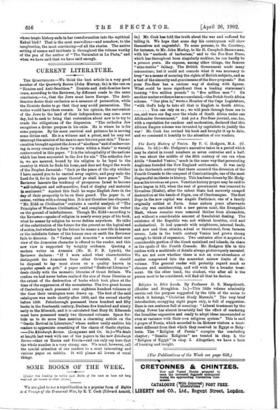The Early Ilistory of Venice. By F. C. Hodgson, M.A.
(G. Allen. 7s. 6d.)—Mr. Hodgson's narrative takes in a period which may be stated in round numbers as seven centuries and a half. It was about the middle of the fifth century of our era when Attila "founded Venice," much in the same way that persecuting Anglicans founded the New England settlements. It was early in the thirteenth century that there occurred the diversion of the Fourth Crusade to the conquest of Constantinople, one of the most disgraceful incidents in history. This has been chosen by Mr. Hodg- son as his terminus ad guem. Venetian history proper may be said to have begun in 813, when the seat of government was removed to Rivoaltus (Rialto), after the infant State had narrowly escaped destruction at the hands of Pepin, son of Charlemagne. The first Doge in the new capital was Angelo Particiaco, one of a family originally settled at Pavia. Some sixteen years afterwards the city was enriched with a new patron saint, the Evangelist Mark, whose remains were removed thither from Alexandria, not without a considerable amount of fraudulent dealing. The existence of the Republic was not without troubles, civil and ecclesiastical. It had quarrels with neighbours, internal feuds, and now and then attacks, actual or threatened, from Saracen rovers. Late in the tenth century Venice had grown strong enough to think of expansion. Two centuries after it acquired a considerable portion of the Greek mainland and islands, its share in the spoils of the Fourth Crusade. Mr. Hodgson fills in this outline with a multitude of details always picturesquely narrated. We are not sure whether there is not an over-abundance of matter compressed into the somewhat narrow limits of the volume. The general reader will probably regard much as obscure and uninteresting, and will wish for a broader treat- ment. On the other hand, the student, who after all is the person most to be considered, will find all that he desires.


























































 Previous page
Previous page